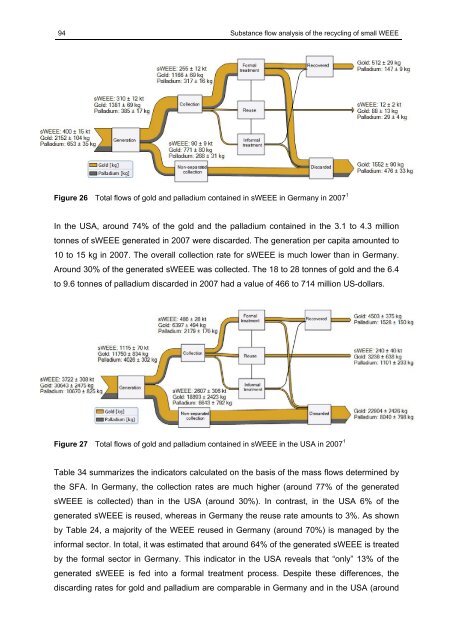SUbstance flow analysis of the recycling of small waste electrical ...
SUbstance flow analysis of the recycling of small waste electrical ...
SUbstance flow analysis of the recycling of small waste electrical ...
You also want an ePaper? Increase the reach of your titles
YUMPU automatically turns print PDFs into web optimized ePapers that Google loves.
94 Substance <strong>flow</strong> <strong>analysis</strong> <strong>of</strong> <strong>the</strong> <strong>recycling</strong> <strong>of</strong> <strong>small</strong> WEEE<br />
Figure 26 Total <strong>flow</strong>s <strong>of</strong> gold and palladium contained in sWEEE in Germany in 2007 1<br />
In <strong>the</strong> USA, around 74% <strong>of</strong> <strong>the</strong> gold and <strong>the</strong> palladium contained in <strong>the</strong> 3.1 to 4.3 million<br />
tonnes <strong>of</strong> sWEEE generated in 2007 were discarded. The generation per capita amounted to<br />
10 to 15 kg in 2007. The overall collection rate for sWEEE is much lower than in Germany.<br />
Around 30% <strong>of</strong> <strong>the</strong> generated sWEEE was collected. The 18 to 28 tonnes <strong>of</strong> gold and <strong>the</strong> 6.4<br />
to 9.6 tonnes <strong>of</strong> palladium discarded in 2007 had a value <strong>of</strong> 466 to 714 million US-dollars.<br />
Figure 27 Total <strong>flow</strong>s <strong>of</strong> gold and palladium contained in sWEEE in <strong>the</strong> USA in 2007 1<br />
Table 34 summarizes <strong>the</strong> indicators calculated on <strong>the</strong> basis <strong>of</strong> <strong>the</strong> mass <strong>flow</strong>s determined by<br />
<strong>the</strong> SFA. In Germany, <strong>the</strong> collection rates are much higher (around 77% <strong>of</strong> <strong>the</strong> generated<br />
sWEEE is collected) than in <strong>the</strong> USA (around 30%). In contrast, in <strong>the</strong> USA 6% <strong>of</strong> <strong>the</strong><br />
generated sWEEE is reused, whereas in Germany <strong>the</strong> reuse rate amounts to 3%. As shown<br />
by Table 24, a majority <strong>of</strong> <strong>the</strong> WEEE reused in Germany (around 70%) is managed by <strong>the</strong><br />
informal sector. In total, it was estimated that around 64% <strong>of</strong> <strong>the</strong> generated sWEEE is treated<br />
by <strong>the</strong> formal sector in Germany. This indicator in <strong>the</strong> USA reveals that “only” 13% <strong>of</strong> <strong>the</strong><br />
generated sWEEE is fed into a formal treatment process. Despite <strong>the</strong>se differences, <strong>the</strong><br />
discarding rates for gold and palladium are comparable in Germany and in <strong>the</strong> USA (around

















